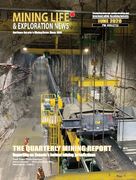Bad Times for Canada's Big Gold Miners

Barrick Gold Corp. chairman John Thornton announced moves toward a leaner company
Thursday.
Barrick Gold Corp. chairman John Thornton’s message to Bay Street came through loud and clear: he wants to take the world’s largest gold producer back to its roots as a smaller company with fewer mines and micro-managers — and hopefully return it to profitability.
To that end, the Toronto mining giant is slashing staff at headquarters by nearly half and selling two Asia-Pacific mines. It will be “laser focused” on reducing its debt by $3 billion this year amid rocky times in the mining industry and a weak gold price, he told analysts on a conference call Thursday.
It wasn’t a banner day for either of Canada’s two largest bullion miners, as Vancouver-based Goldcorp Inc. reported a loss of $2.4 billion (U.S.) in its latest quarter as it wrote down the value of its Cerro Negro mine in Argentina. Barrick also reported a massive $2.85 billion fourth-quarter loss due to an after-tax impairment charge on its soon-to-be closed Lumwana copper mine in Zambia and the Cerro Casale project in Chile.
Gold miners are struggling as the gold price has lost 35 per cent of its value since its peak of $1,900 (U.S.) an ounce in 2011 and as the industry suffers through a brutal downturn following a 13-year market rally.
“When companies falter, it is usually because they’ve forgotten their original DNA — that is to say, what it is that made them distinctive and gave them their purpose and values and made them successful,” said Thornton, who has steered clear of quarterly conference calls since taking the helm from Barrick founder Peter Munk last April.
“We believe the only way to recapture that is to consciously go back to the future and understand who we were, what made us distinctive, what gave us our purpose and our values and reinterpret that for the 21st century,” he said of the firm that began with one mine in 1983.
The former Goldman Sachs banker detailed his plan to make the company more “lean and nimble with less bureaucracy” by cutting jobs at its Toronto head office from 260 last year to 140 in 2015. Since taking the helm, he eliminated the chief executive position and has shaken up the top ranks by replacing nearly every other executive.
Thornton also drove home the point that the miner’s main focus is gold, despite saying initially the company might set its sights elsewhere even after the firm’s disastrous foray into copper a few years ago at the height of the mining boom that helped sink the company deeper into debt.
“We have no plans to diversify into other metals and we have no plans to add to our existing copper position,” Thornton noted.
Thornton also set a year-end target to cut Barrick’s net debt by 30 per cent, which includes plans to sell two problematic mines in Australia and Papua New Guinea and potentially other assets. In the last few years, Barrick has shrunk from 27 operating mines to 18 and shelved its massive Pascua-Lama project in the Andes due to billions of dollars in cost overruns.
“Well at least there’s less mystery there now that he brought out his playbook,” said gold analyst John Ing, president of Maison Placements Inc., referring to Thornton’s first time on an earnings call.
“There was a lot of wonderment on Bay Street about what was going on,” which contributed to the miner’s lackluster share price that fell more than 30 per cent over the last year, said Ing.
Barrick shares got a boost Thursday, climbing 5 per cent to close at $16.03 on the Toronto Stock Exchange.
He said it’s about time Barrick streamlined the organization and sent a clear signal to the market of its agenda going forward.
“Over time, Barrick got very bureaucratic. If you were at a mine and you needed to order a part, you had to go through head office,” said Ing.
Barrick reported revenue of $2.51 billion, down $2.94 billion as the company sold fewer ounces of gold —1.57 million versus 1.83 million — at an average realized price of $1,204 per ounce compared with $1,272 in the fourth quarter of 2013.
Meanwhile, Goldcorp said its revenue in the fourth quarter was $835 million, down from $956 million in the comparable period of 2013.
Source: http://www.thestar.com/business/2015/02/19/bad-times-for-canadas-big-gold-miners.html

|